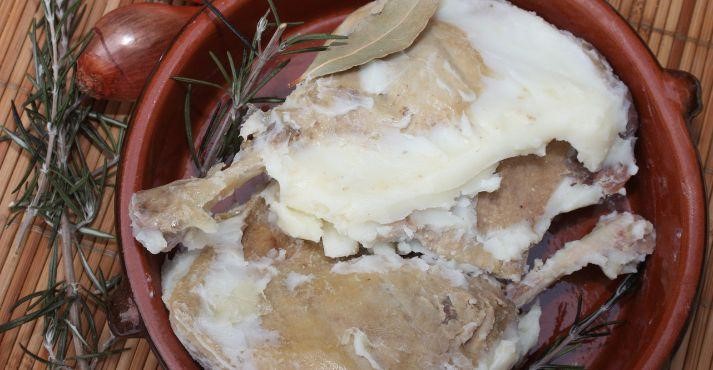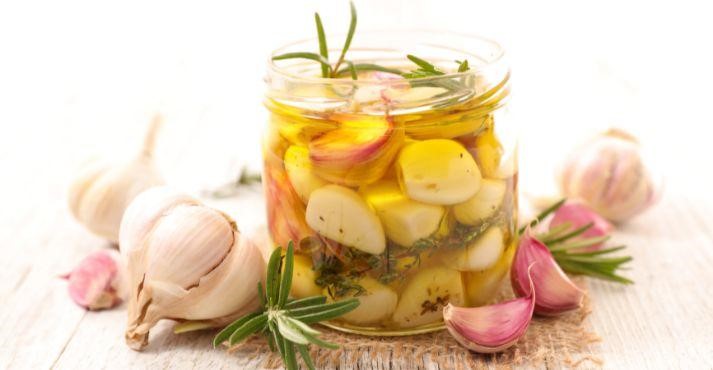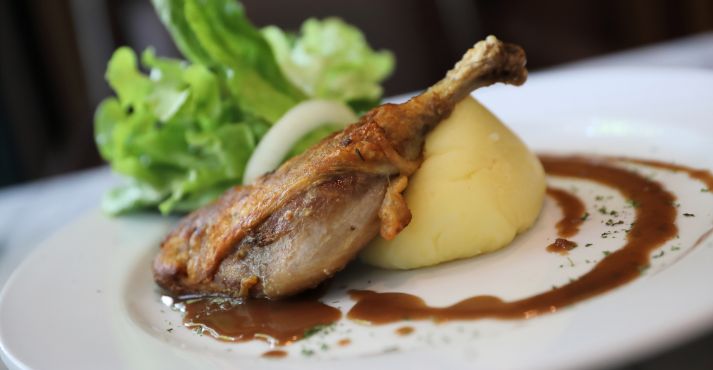Have you ever wondered how ancient cooks kept their food delicious and safe to eat without the help of modern refrigeration? One of their secrets was confit cooking.
This classic French technique is a fascinating piece of culinary history and an essential method for creating rich, flavorful dishes in today’s food industry.
Confit is a process where food is slowly cooked in a liquid, usually fat, to preserve it. This method ensures that the food remains tender and flavorful over extended periods.
Originally used to store meats for long-term use, confit has evolved into a gourmet delicacy enjoyed by food enthusiasts worldwide. Its significance in the food industry lies in its ability to transform simple ingredients into luxurious melt-in-your-mouth experiences.
Understanding what confit is and its applications can open up a new world of culinary possibilities for any home cook or professional chef.
What is Confit?

Confit is a traditional French cooking method that involves slowly cooking food in a liquid, usually fat, to preserve it. The word confit comes from the French verb “confire,” which means to preserve.
Historically, this technique was essential for keeping food safe to eat before the invention of refrigeration. Cooking food at a low temperature for an extended period makes it incredibly tender, flavorful, and protected from spoilage.
The roots of confit can be traced back to rural France, where farmers needed a reliable way to preserve meats like duck, goose, and pork for the winter months. They would cure the meat with salt and spices, then simmer it in fat.
This method kept the meat from spoiling and enhanced its flavor and grain. Today, understanding confit food is celebrated in kitchens worldwide for its ability to create delicious, long-lasting dishes.
History and Origin of Confit
Confit is a time-honored technique rooted in French culinary tradition. Developed initially to preserve meats, this slow-cooking process has transformed from a practical necessity into a celebrated gourmet practice. Let’s look into the rich history and evolution of confit.
Historical Background
The practice of confit dates back centuries in France, where it was an essential method for preserving meats before the advent of refrigeration. Traditionally, meats like duck, goose, and pork were cured with salt and aromatics and then slowly cooked in their fat.
This method was effective for food preservation and improved the flavor and texture of the meat. The preserved meat could be stored for several months, providing a reliable food source during the winter. This technique is what confit cooking initially entailed: a blend of necessity and food craft.
Evolution of Confit
Over time, confit has evolved from a practical preservation method to a sought-after culinary treat. Modern chefs have expanded beyond traditional meats, applying confit methods to vegetables, seafood, and fruits.
While preservation is less critical today, the rich, tender flavors achieved through confit continue to make it a popular food dish in Asia. In contemporary kitchens, the term has also shifted from a noun to a verb, with chefs frequently saying they will “confit” an ingredient.
This evolution reflects how confit food has become integral to gourmet cooking, appreciated for its unique and appealing results.
The Confit Technique

The confit technique involves slow cooking and preservation. This method ensures that the food remains tender and flavorful and can be stored for an extended period. Let’s break down the detailed process of making confit from start to finish.
Detailed Process
Ingredients:
- Meat or Vegetables: Common choices include duck, goose, pork, garlic, and onions.
- Fat: Duck fat, goose fat, or olive oil for vegetables.
- Salt: Used for curing the meat beforehand.
- Aromatics: Garlic, thyme, bay leaves, and peppercorns are often used to enhance flavor.
Preparation:
- Curing: Begin by rubbing the meat with a generous amount of salt and aromatics. This step is crucial for flavor and preservation. Place the meat in a dish, cover it, and let it cure in the refrigerator for 24 hours.
- Rinsing: After curing, rinse the meat to remove excess salt and pat it dry with paper towels.
- Prepping Vegetables: If using vegetables like garlic or onions, peel and clean them, ensuring they are ready for slow cooking.
Cooking:
- Submerging in Fat: Place the meat or vegetables in a heavy pot or Dutch oven and cover them with the chosen fat. For meat, use duck or goose fat; olive oil works well for vegetables.
- Low and Slow Cooking: Heat the pot over low heat or in an oven set to a low temperature, around 200 degrees Fahrenheit (95 degrees Celsius). The goal is to simmer the food, allowing it to tenderize without boiling.
- Duration: Cook the meat for several hours, typically 2-6 hours, depending on the type and size of the meat. Vegetables take less time, usually about 1-2 hours.
- Storage: Once cooked, let the confit cool in the fat. Transfer the pieces to a container, ensuring they are fully submerged in fat, and store them in the refrigerator.
Types of Fats Used
The choice of fat in confit cooking significantly affects the flavor and texture of the final dish. Duck fat is the most traditional and popular choice, known for its rich flavor and smooth texture.
It boosts the meat’s natural taste and adds a luxurious mouthfeel. Goose fat is similar, offering a slightly lighter flavor but delivering excellent results.
Olive oil is a fantastic option for vegetables. It imparts a subtle, fruity flavor that complements the vegetables’ natural taste.
Olive oil is also a healthier alternative, being rich in monounsaturated fats. Each type of fat brings unique characteristics to the confit food, allowing for various delicious outcomes depending on the chosen ingredients.
Equipment Needed
Making confit requires a few essential tools to ensure the process is smooth and successful:
- Heavy Pot or Dutch Oven: These are ideal for maintaining a consistently low temperature and ensuring even cooking.
- Thermometer: A reliable kitchen thermometer helps monitor the oil temperature, keeping it around 200 degrees Fahrenheit (95 degrees Celsius) to prevent overheating.
- Tongs: Useful for handling hot meat or vegetables when placing them in or removing them from the fat.
- Storage Containers: Airtight containers are necessary for storing confit. Ensure the pieces are fully submerged in fat to maintain their preservation.
- Cooling Rack: After cooking, a cooling rack helps drain excess fat before storing the confit.
With these tools, you can confidently prepare and store confit dishes, ensuring they are perfectly cooked and preserved effectively.
Benefits of Confit
The confit method is celebrated for its historical roots, preservation capabilities, and remarkable culinary benefits. From enhancing flavors to improving texture, confit is a versatile technique that brings out the best in various ingredients.
Flavor Enhancement

One of the primary benefits of confit cooking is the significant boost in flavor. When food is simmered in fat, it absorbs its rich, savory qualities while retaining its distinct taste.
This slow cooking process allows the flavors of the aromatics, such as garlic, thyme, and bay leaves, to infuse the meat or vegetables deeply.
For instance, duck confit becomes exceptionally flavorful, with the fat imparting a luscious, melt-in-your-mouth quality that simple roasting cannot achieve.
The extended cooking time ensures that the flavors develop fully, resulting in a complex and satisfying dish.
Preservation
Historically, confit was a crucial method for preserving meats before the invention of refrigeration. Cooking meat in its fat and storing it submerged in it creates an environment inhospitable to bacteria.
This technique allowed meat to be stored for several months without spoiling, providing a reliable food source when fresh meat was unavailable.
Even today, the preservation aspect of confit is valuable. Properly stored confit food can last for weeks in the refrigerator, making it a practical choice for those who want to prepare meals in advance and enjoy them later.
This historical method showcases the ingenuity of past generations in food preservation.
Texture and Moisture
The texture and moisture content of confit are unparalleled. The low and slow cooking process breaks down the connective tissues in the meat, resulting in an incredibly tender and succulent texture.
Unlike high-heat cooking methods that can dry out food, confit retains the natural moisture, making the meat juicy and flavorful. Vegetables cooked using the confit method also benefit from this technique, becoming tender and infused with the rich flavors of the cooking fat.
Confit cooking results in a moist and tender dish with a texture almost melts in your mouth.
Confit in Modern Cuisine

Confit has evolved from a traditional preservation method to a beloved technique in modern kitchens. Its versatility and flavor-enhancing properties make it a favorite among chefs and home cooks.
Let’s define confit in terms of usage in contemporary dishes, the innovations in its preparation, and some delightful food pairings to augment your dining experience.
Applications
In modern cuisine, confit is not limited to meats like duck and goose. Chefs now use this method for various ingredients, including vegetables and seafood.
For instance, garlic confit is a popular addition to many dishes. Its sweet and mellow garlic flavor is perfect for spreading on bread or mixing into sauces.
Confit tomatoes are another contemporary twist. They offer a rich, concentrated flavor that pairs well with pasta, salads, and bruschetta. This technique is also applied to fish, where it helps maintain a tender, moist texture, making dishes like salmon confit a luxurious treat.
Innovations
Modern chefs have introduced several innovations to the traditional confit cooking method. One notable innovation is the use of sous vide technology.
By cooking the meat in a vacuum-sealed bag submerged in a water bath at a controlled low temperature, chefs can achieve the same tender results as traditional confit without needing large quantities of fat.
This method also allows for precise control over the cooking process, ensuring perfect results every time. Additionally, some chefs experiment with different fats, such as coconut oil or ghee, to impart unique flavors to the confit food.
Food Pairings
Confit dishes pair wonderfully with various foods and wines, enhancing the dining experience. For example, duck confit pairs beautifully with roasted potatoes, sautéed greens, and a glass of Pinot Noir, which complements the rich flavors of the duck.
Garlic confit can be spread on a baguette and enjoyed with a light, crisp white wine like Sauvignon Blanc. For a delightful vegetarian option, serve confit tomatoes with fresh mozzarella and basil, accompanied by a glass of Chardonnay.
These pairings highlight the flavors of the confit dishes and create a balanced and enjoyable meal.
Confit Variations and Beyond Duck

Dive into the world of confit beyond the familiar quack, exploring various variations and proteins that chefs skillfully prepare using this timeless technique.
Let’s unravel the culinary creativity that goes into experimenting with different meats, offering a diverse range of compelling confit options.
Beyond Duck Confit: A World of Culinary Exploration
While duck confit has its place in culinary history, the world of confit extends far beyond the quack. Armed with culinary curiosity, chefs venture into a realm of possibilities, exploring various proteins and crafting various confit preparations that captivate diners’ palates.
Confit Variations: A Symphony of Proteins
The beauty of confit lies in its ability to embrace various proteins, each offering a unique culinary symphony.
From succulent chicken and turkey to flavorful rabbit and lamb, chefs orchestrate a diverse range of confit variations that showcase the versatility of this time-honored cooking method.
Exploring Confit Varieties: A Chef’s Canvas
In the hands of skilled chefs, confit becomes a canvas for exploration. Each protein brings its character, and chefs, like artists, experiment with flavors, textures, and aromas. The result is a gallery of confit varieties where culinary creativity knows no bounds.
Diverse Confit Preparations: A Culinary Extravaganza
The culinary world embraces the diversity of confit preparations—chefs, driven by a passion for experimentation, present diners with tempting options.
Whether pork confit with a hint of spice, aromatic duck leg confit, or tender rabbit confit infused with herbs, the possibilities are as varied as the proteins themselves.
Culinary Creativity: Chef’s Experimentation Unleashed
Chefs, the true alchemists in the kitchen, experiment with different meats, turning each confit preparation into a masterpiece.
Culinary creativity knows no boundaries as chefs explore the nuances of various proteins, adapting the slow-cooking technique to enhance the natural flavors of each ingredient.
Diverse Range of Confit Offerings: Pleasing Every Palate
The allure of diverse confit offerings lies in their ability to please every palate. From duck’s richness to rabbit’s delicate flavors and pork’s heartiness, every taste preference has a confit variation.
Chefs curate menus celebrating this diversity, ensuring a delightful experience for diners seeking variety.
What is confit – FAQs
Is confit a healthy way of cooking?
Confit can be healthy if consumed in moderation. While the method involves cooking in fat, the food doesn’t absorb much. Using healthier fats, like olive oil, and pairing confit dishes with vegetables can make it a balanced part of your diet.
What to serve with duck confit?
Duck confit pairs well with roasted potatoes, sautéed greens, and lentils. These accompaniments balance the duck’s rich flavor and create a satisfying meal.
Conclusion
In conclusion, our exploration into the world of confit has uncovered a rich culinary tradition, showcasing its versatile adaptation to Singaporean cuisine.
The art of confit preparation has not only stood the test of time but has also evolved to meet the demands of modern culinary experiences.
As we wrap up this culinary journey, the enduring appeal of confit becomes evident, harmonizing tradition with contemporary tastes. Its seamless integration into Singaporean cuisine speaks volumes about the adaptability of culinary traditions.
The versatility of confit not only enriches our dining experiences but also points towards a continual evolution of this timeless culinary art.





























